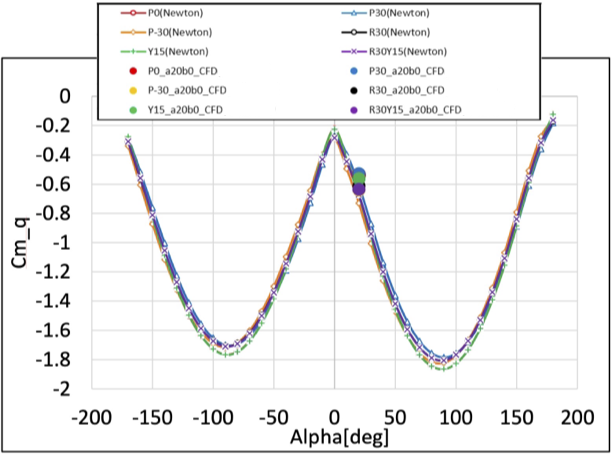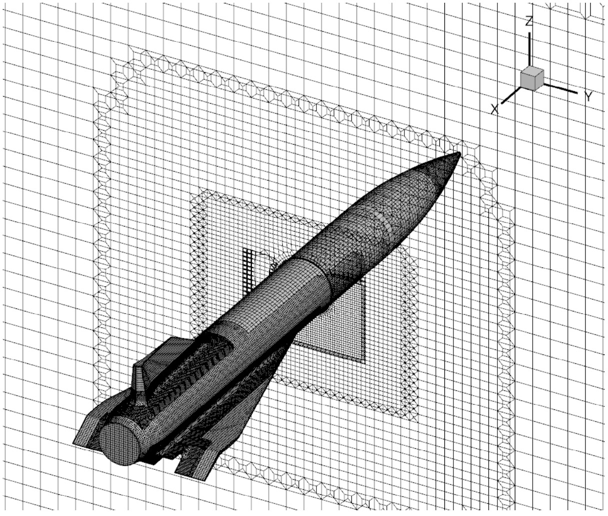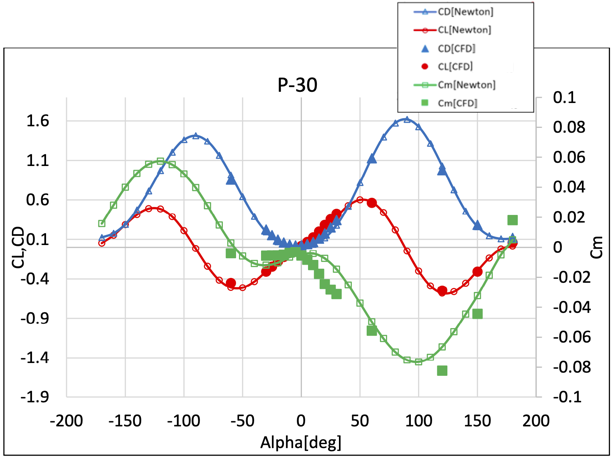Research on dynamic attitude stability evaluation of high-speed flying objects using CFD
JAXA Supercomputer System Annual Report February 2024-January 2025
Report Number: R24EACA60
Subject Category: JSS Inter-University Research
- Responsible Representative: Koji Miyaji, Professor, Yokohma National University
- Contact Information: Koji Miyaji(miyaji@ynu.ac.jp)
- Members: Kazuki Hyodo, Koji Miyaji, Kenichiro Takayanagi
Abstract
The static and dynamic stability of high-speed flying objects are evaluated by CFD. We Actual analysis target is the High-Mach Integrated Control experiment (HIMICO), a hypersonic integrated control experiment being jointly researched and developed by JAXA and several universities. We compare CFD analysis, which has a high computational load but is versatile and expected to be highly accurate, with simple hypersonic Newtonian flow analysis that uses CFD surface grids. We investigate calculation methods that combine accuracy and efficiency to obtain the dynamic stability derivatives required for trajectory calculation and attitude control.
Reference URL
N/A
Reasons and benefits of using JAXA Supercomputer System
For steady and unsteady Computational Fluid Dynamics (CFD) aerodynamic analysis around high-speed flying objects with complex shapes, a supercomputer capable of high-speed calculations is necessary. In JSS3, not only self-developed codes but also execution of analysis tools provided by JAXA are possible.
Achievements of the Year
(Figure 1) shows the configuration (elevon rudder angle -30 deg.) and the computational grid. (Figure 2) shows the change in lift coefficient CL, drag coefficient CD, and pitching moment coefficient Cm when the angle of attack is changed at a flight Mach number of 5. The solid symbols are the CFD analysis results. Many of the analysis results shown with hollow symbols and solid lines are from the hypersonic Newtonian flow approximation. In Newtonian flow, only a surface grid is required, and a coarse grid is usually used, but the fine surface grid for CFD was used as is. Over a wide range of angles of attack, the agreement of the aerodynamic coefficients of both methods is generally reasonable, but there is a difference in static stability (the slope of Cm) near the angle of attack of 0. Although not shown here, the discrepancy between the two methods increases at Mach numbers of around 3.
(Figure 3) shows the change in pitch dynamic stability derivative with respect to the change in angle of attack for six shapes, including no elevon angle, reversed elevon angle (aircraft roll control), and the rudder angle, and so on. The Newton flow approximation, which has a low computational load, shows the results for many cases, while the CFD shows only the result for an angle of attack of 20 deg. The pitch dynamic stability derivative in CFD is calculated from the pitching moment for a steady rotation in the pitch direction around the center of gravity. d(Cm)/dq is calculated by finite differences from the change in Cm for different rotational angular velocities q. A comparison of the two analysis methods shows that the two agree well. However, discrepancies arise as the Mach number decreases, and the Newton flow approximation requires the development of a method to calculate other longitudinal stability derivatives (the rate of change in Cm with respect to the time change in the angle of attack).

Fig.3: Comparison of CFD and hypersonic Newtonian approximations for longitudinal dynamic stability derivatives
Publications
N/A
Usage of JSS
Computational Information
- Process Parallelization Methods: MPI
- Thread Parallelization Methods: N/A
- Number of Processes: 72 - 576
- Elapsed Time per Case: 8 Hour(s)
JSS3 Resources Used
Fraction of Usage in Total Resources*1(%): 0.01
Details
Please refer to System Configuration of JSS3 for the system configuration and major specifications of JSS3.
| System Name | CPU Resources Used(Core x Hours) | Fraction of Usage*2(%) |
|---|---|---|
| TOKI-SORA | 0.00 | 0.00 |
| TOKI-ST | 91225.63 | 0.09 |
| TOKI-GP | 0.00 | 0.00 |
| TOKI-XM | 0.00 | 0.00 |
| TOKI-LM | 329.15 | 0.02 |
| TOKI-TST | 0.00 | 0.00 |
| TOKI-TGP | 0.00 | 0.00 |
| TOKI-TLM | 0.00 | 0.00 |
| File System Name | Storage Assigned(GiB) | Fraction of Usage*2(%) |
|---|---|---|
| /home | 0.00 | 0.00 |
| /data and /data2 | 10240.00 | 0.05 |
| /ssd | 0.00 | 0.00 |
| Archiver Name | Storage Used(TiB) | Fraction of Usage*2(%) |
|---|---|---|
| J-SPACE | 0.00 | 0.00 |
*1: Fraction of Usage in Total Resources: Weighted average of three resource types (Computing, File System, and Archiver).
*2: Fraction of Usage:Percentage of usage relative to each resource used in one year.
ISV Software Licenses Used
| ISV Software Licenses Used(Hours) | Fraction of Usage*2(%) | |
|---|---|---|
| ISV Software Licenses(Total) | 0.59 | 0.00 |
*2: Fraction of Usage:Percentage of usage relative to each resource used in one year.
JAXA Supercomputer System Annual Report February 2024-January 2025




